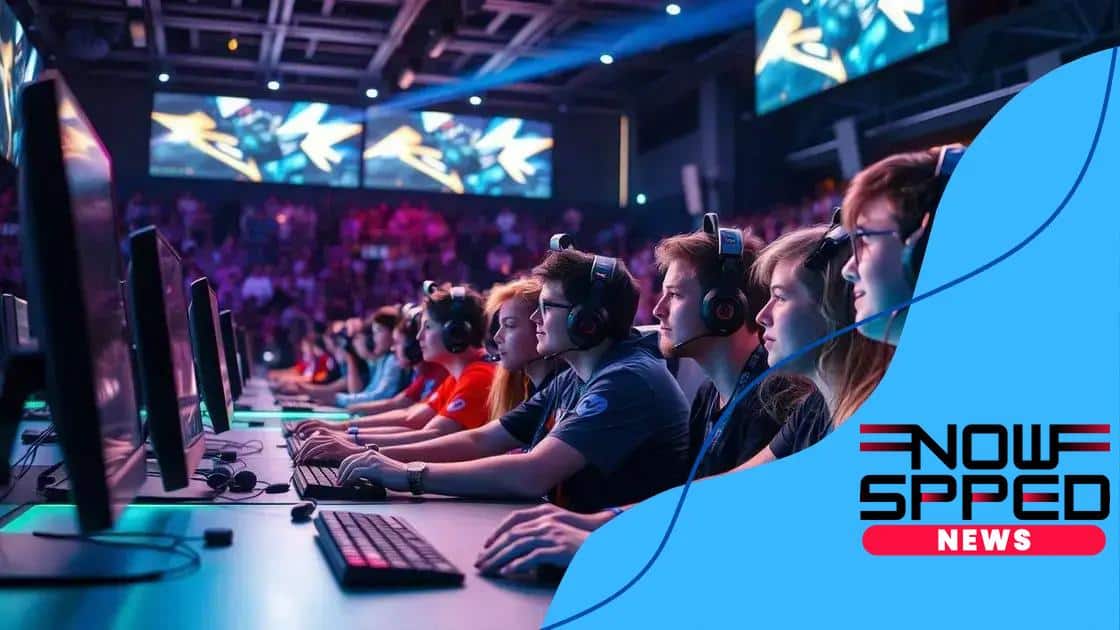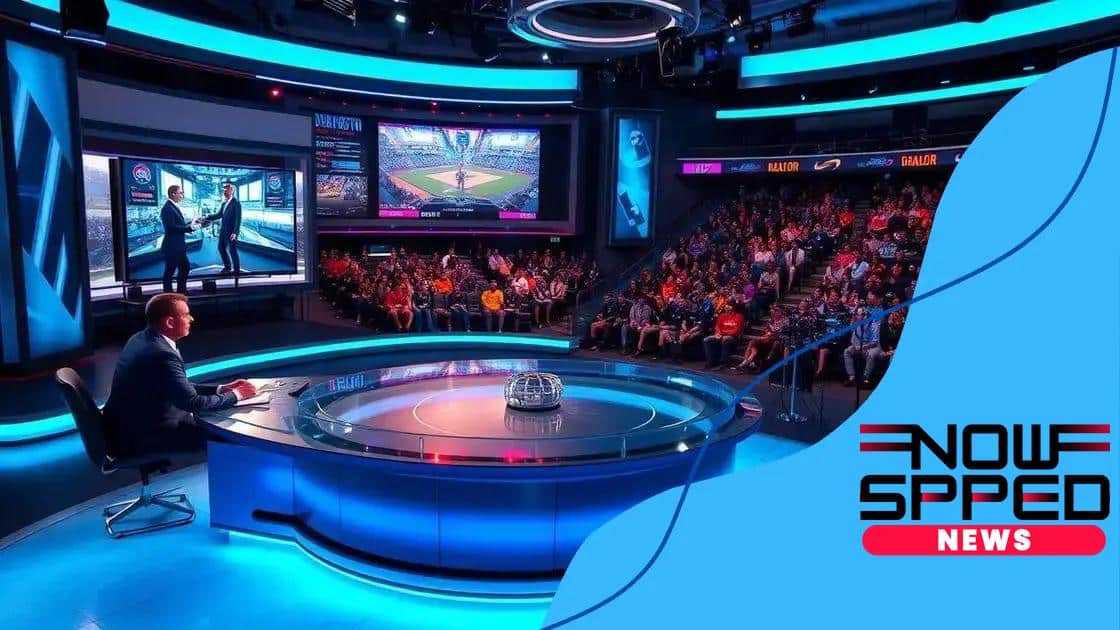How e-sports are influencing mainstream media content

How e-sports are influencing mainstream media content is evident through the rise of personalized viewing, immersive technologies, and community-driven engagement, reshaping entertainment and audience interactions.
How e-sports are influencing mainstream media content is a fascinating topic that’s changing the way we consume entertainment. Have you noticed how often video games and competitive gaming appear in our favorite shows? Let’s take a closer look at this trend.
The rise of e-sports in popular culture
The rise of e-sports in popular culture has been remarkable, transforming how we think about gaming and entertainment. Once considered a niche interest, competitive gaming has blossomed into a mainstream phenomenon.
Many young people admire professional gamers, viewing them as celebrities. This admiration fuels a growing interest in e-sports, making it a staple in modern entertainment.
Factors Contributing to the Popularity of E-sports
Several key factors have driven this surge:
- Accessibility of online gaming platforms.
- Engaging content through live streaming.
- Community building around competitive events.
The accessibility of gaming has enabled more individuals to participate. As e-sports events are streamed online, viewers from all over the world can watch their favorite players compete. This opens up a sense of belonging within the gaming community.
Influence of Social Media
Social media also plays a huge role in the rise of e-sports. Platforms like Twitch and YouTube allow gamers to showcase their skills and engage with thousands of fans. These platforms foster a direct connection, allowing players to interact and build relationships with their audience.
This interaction enhances the viewing experience, making it more immersive. Fans cheer for their favorite gamers, creating virtual communities centered around shared interests. As players gain popularity, they often become influencers, driving further engagement.
Events like the League of Legends World Championship draw millions of viewers, similar to traditional sporting events. Major brands recognize this growing audience, leading to partnerships that help e-sports reach new heights.
Ultimately, the blend of accessibility, compelling content, and social interaction has paved the way for e-sports to thrive in popular culture. This evolution not only enriches the gaming landscape but also reshapes broader media narratives.
How e-sports are shaping media narratives
How e-sports are shaping media narratives is a significant development in the entertainment world. As e-sports gains popularity, traditional media outlets adapt their content to cover this phenomenon.
News channels, blogs, and social media platforms now feature e-sports updates alongside regular sports news. This shift shows how gaming is no longer just a pastime but an essential part of our culture.
The Impact on Storytelling
One of the primary ways e-sports influences media narratives is through storytelling. Compelling stories drawn from player journeys and team rivalries are taking center stage. These narratives engage fans and create emotional connections.
- Player backstories highlight struggles and triumphs.
- Rivalries between teams generate excitement and anticipation.
- Charitable efforts within the community showcase a positive impact.
Through these stories, e-sports creates a narrative framework similar to traditional sports. Fans become more invested, leading to a stronger community bond.
The Language of E-sports
Another contribution of e-sports to media narratives is its unique language and slang. Terms like “clutch” and “frag” become part of the mainstream lexicon, enriching our conversation. As more newcomers engage, this vocabulary spreads through various forms of media.
Television networks and online platforms now use this language to attract younger audiences. By incorporating gamer jargon, they make their broadcasts relatable and engaging, bridging the gap between cultures.
The inclusion of e-sports in documentaries and films further illustrates its influence. These visual stories present the challenges and triumphs of gamers, offering a deeper understanding of their world. As more people watch these productions, the narratives expand, reaching beyond just gamers.
Overall, how e-sports are shaping media narratives reflects a major shift in entertainment. Its progression into mainstream media continues to evolve, paving the way for new stories and connections.
The role of major networks in e-sports coverage

The role of major networks in e-sports coverage has become increasingly vital as the industry grows. Traditional sports networks are now expanding their reach to include e-sports, recognizing the demand for content in this area.
By investing in e-sports programming, networks attract a younger audience eager for gaming content. This shift indicates a broader acceptance of gaming as a legitimate form of entertainment.
Integration into Sports Programming
Major networks are not just covering e-sports events; they are integrating them into their regular sports programming. For instance, channels often broadcast tournaments similar to traditional sports events. This approach fosters a more inclusive view of gaming.
- Live broadcasts of tournaments draw large audiences.
- Expert commentary enhances viewer experience.
- Interviews with top players create engaging content.
With increased professional commentary, viewers gain insights that deepen their understanding of the games. This makes e-sports coverage more accessible to newcomers.
Partnerships and Sponsorships
Networks also partner with gaming companies for promotions and sponsorships. These collaborations elevate the profile of e-sports and attract large brands looking to reach gamers. Such sponsorships benefit both the games and the broadcasters.
More companies are realizing the potential audience in the e-sports community. As a result, ad placements during broadcasted tournaments are becoming common, reinforcing the industry’s growth.
Major networks are thus playing a critical role in the evolution of e-sports. Their involvement helps legitimize gaming as a sport and strengthens its community. As this relationship develops, we can expect more exciting content and innovative programming in the future.
Audience engagement in e-sports vs. traditional sports
Audience engagement in e-sports vs. traditional sports shows significant differences. While both types of sports attract passionate fans, the ways they engage audiences are evolving. E-sports offers unique opportunities for interaction that traditional sports often can’t match.
In traditional sports, fans generally view events passively. They watch games on television or attend live matches, cheering for their teams. However, the rising popularity of e-sports has brought new levels of engagement.
Interactive Features in E-sports
One of the standout features of e-sports is its high level of interactivity. Viewers can:
- Participate in live chats during matches.
- Vote on game outcomes and strategies.
- Engage with players through social media.
This real-time interaction fosters a sense of community among fans. They feel more connected not only to the games but also to each other, enhancing their overall viewing experience.
Social Media Presence
Social media plays a crucial role in e-sports engagement. Fans actively follow their favorite players, teams, and tournaments. Many players live-stream their gameplay, providing fans with behind-the-scenes glimpses and engaging them directly.
This level of access creates a strong bond between players and their audiences. In contrast, traditional sports also use social media, but the engagement is often more promotional rather than interactive. Fans share highlights and score updates, but they do not participate in the same way.
Overall, audience engagement in e-sports offers a more immersive experience. By utilizing interactive features and emphasizing social media connections, e-sports provides a unique environment for fans to thrive. This evolution in audience engagement highlights the changing landscape of entertainment as e-sports continues to grow.
Future trends: e-sports and digital content
Future trends in e-sports and digital content showcase an exciting path for gaming and entertainment. As technology evolves, so does the landscape of e-sports, leading to new opportunities for players, brands, and audiences alike.
One prominent trend is the integration of virtual and augmented reality. These technologies allow fans to engage with e-sports events in immersive ways. Imagine watching a match where you can feel as if you’re sitting right next to the players.
Personalized Viewing Experiences
Another trend is the rise of personalized viewing experiences. Streaming platforms are beginning to tailor content to individual preferences. This means fans can select what aspects of a match they want to view, such as specific player stats or strategies.
- Enhanced graphics and real-time statistics.
- Customizable camera angles during live events.
- On-demand highlights based on viewer preferences.
Such options not only make viewing more enjoyable but also help create a deeper connection with the game. Viewers can analyze plays and strategies, making them feel like part of the action.
Community-Driven Content
Community-driven content is also gaining traction in the e-sports space. This involves fans creating and sharing their own content related to games and players. User-generated highlights, memes, and commentary can amplify engagement and foster a sense of belonging.
Platforms are increasingly allowing fans to contribute, making for a rich tapestry of content that showcases diverse perspectives. Brands are recognizing this and often collaborate with fans to create unique promotional campaigns.
In conclusion, the future of e-sports and digital content looks bright. Innovations such as virtual reality, personalized viewing, and community-driven content will shape how audiences engage with e-sports. As technology continues to advance, so too will the ways we experience and enjoy gaming.
FAQ – Frequently Asked Questions about E-sports and Digital Content
What trends are shaping the future of e-sports?
Future trends in e-sports include personalized viewing experiences, virtual reality engagement, and community-driven content.
How does virtual reality enhance the e-sports experience?
Virtual reality allows fans to feel immersed in the game, making them feel like they are part of the action during live events.
Why is personalized viewing important in e-sports?
Personalized viewing tailors content based on fan preferences, providing a more engaging and enjoyable experience.
What is community-driven content in e-sports?
Community-driven content refers to fans creating highlights, commentary, and other content that enhances viewer engagement and connection.





